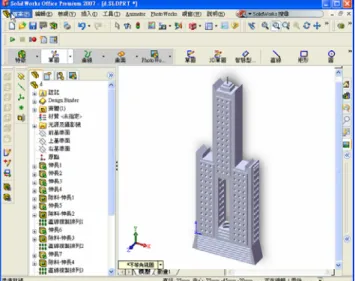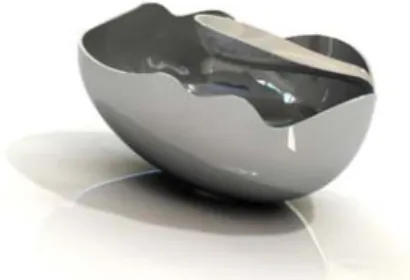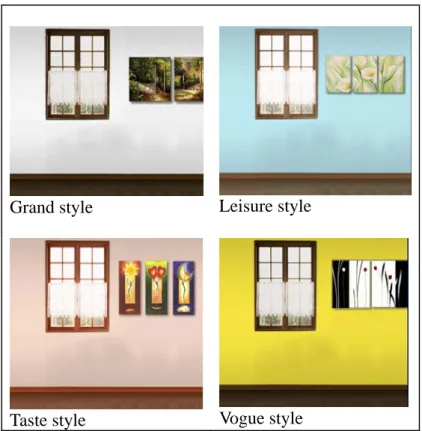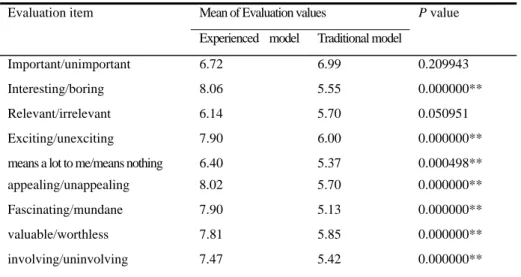行政院國家科學委員會專題研究計畫 成果報告
地方文化元素探究與文化創意產品設計-以高雄意象為例
(I)
研究成果報告(精簡版)
計 畫 類 別 : 個別型 計 畫 編 號 : NSC 97-2410-H-151-010- 執 行 期 間 : 97 年 08 月 01 日至 98 年 10 月 31 日 執 行 單 位 : 國立高雄應用科技大學文化事業發展系 計 畫 主 持 人 : 李穎杰 計畫參與人員: 大專生-兼任助理人員:張家飴 博士班研究生-兼任助理人員:張淑美 報 告 附 件 : 出席國際會議研究心得報告及發表論文 處 理 方 式 : 本計畫涉及專利或其他智慧財產權,2 年後可公開查詢中 華 民 國 98 年 11 月 17 日
行政院國家科學委員會補助專題研究計畫
■ 成 果 報 告
□期中進度報告
地方文化元素探究與文化創意產品設計-以高雄意象為例(I)
計畫類別:■ 個別型計畫 □ 整合型計畫
計畫編號:NSC 97-2410-H-151 -010 -
執行期間:97 年 08 月 01 日至 98 年 10 月 31 日
計畫主持人:李穎杰
共同主持人:
計畫參與人員:
博士班研究生-兼任助理人員:張淑美
大專生-兼任助理人員:張家飴
成果報告類型(依經費核定清單規定繳交):■精簡報告 □完整報告
本成果報告包括以下應繳交之附件:
□赴國外出差或研習心得報告一份
□赴大陸地區出差或研習心得報告一份
■出席國際學術會議心得報告及發表之論文各一份
□國際合作研究計畫國外研究報告書一份
處理方式:除產學合作研究計畫、提升產業技術及人才培育研究計畫、
列管計畫及下列情形者外,得立即公開查詢
■涉及專利或其他智慧財產權,□一年■二年後可公開查詢
執行單位:
國立高雄應用科技大學
中 華 民 國 九十八年 十一月 十七日
目錄
========================================================
摘 要 --- 3 前 言 --- 4 研究目的 --- 5 文獻探討 --- 5 研究方法 --- 7 結果與討論 --- 8 結論與建議 --- 10 參考文獻 --- 10 計畫成果自評 --- 12========================================================
摘要
本研究結合文化與設計開發台灣在地的文化創意產品,藉由文化產品傳承文化、行銷 文化,以能建立代表性的文化意象。為達成研究目標,本研究以”高雄意象”為例,從中探 索其所內涵之文化元素,進而將所萃取的文化元素透過創意的設計結合生活流行商品。結 果顯示代表高雄意象主要包含愛河、西子灣、東帝士八五大樓、壽山、夢時代、城市光廊、 蓮池潭、光之塔等。藉由焦點群組法探究各地景之文化意象,並藉由創意的轉換進行生活 用品之設計。在創意發展階段運用電腦輔助設計軟體進行設計,並透過快速成型機將創意 的構想輸出。本研究企盼所採用之研究模式可擴展應用到台灣其他地區進行相關的文化創 意商品開發,以能對學術界與相關產業界做為有價值之參考。 關鍵詞:文化創意、文化元素、文化創意產品、高雄意象 AbstractThis study mainly combines culture and design to develop cultural creativity products in Taiwan. The cultural creativity product can inherit culture, market culture and establish the representative cultural image. In order to achieve the objective, this study takes Kaohsiung as an example and designs a questionnaire to investigate the cultural image. Results show that the representative landscapes in Kaohsiung mainly include Love River, Shi-Hzuwan Bay, Tuntex Sky Tower, Mt. Shoushan, Dream Mall, Urban Spotlight, Lotus Pond, Tower of Light and so on. The cultural elements can be explored from the representative landscapes by the focus group method, and then combined the cultural elements and life popular product via creative design. In the creative development stage, the computer aided design software is adopted to design the creative product. Afterwards, the prototypes of cultural creativity products are made by rapid prototype system. In addition, the research model can be extended to develop related cultural creativity products for other locality in Taiwan. Furthermore, results of this study provide valuable references for academic circles and related industrial field.
1. 前言
文化創意產業可謂是當代顯學,世界各國為因應資本主義產銷關係的全球化網絡建 構,而發起的”全球思考,在地行動”之文化政策浪潮所湧疊而成 (謝素貞,2004)。所謂” 全球化”是社會生活跨越時空界線而重新組合,抽離出社會情境,透過媒介傳播到世界各地 的社會、文化、體制及個人之間,產生了交互關連的過程 (Giddens, 1990)。所謂”在地化” 則是在一個限定的空間內,在地居民所採取的人際關係以及生活模式,此種日常生活被視 為一種理所當然、習慣的、重複性的文化活動,生活在其中的人,可容易且自由地行使文 化自主權,不受外界的干擾 (Featherstone, 1993)。雖然全球化和在地化看似兩個極端的概 念,在全球化的氣氛下,傳統的地方文化不但不會消失,反而會自己調適而更加蓬勃(黃能 揚,1998)。全球化的過程不是產生同質性,而是讓我們熟悉更多元、更廣大的在地文化, 任何在地文化的運作,需要放在全球化的結構下觀照,才能獲得更完整的解釋 (Featherstone, 1993)。在「全球化市場,在地化設計」的影響下,原始藝術逐漸受到重視,透過感受原始 文化的精神意涵,運用現代科技與創意設計,藉由創新產品設計,延續原始藝術文化的價 值,營造地方文化特色,是目前各國文化創意產業的發展趨勢(林榮泰,2007)。文化創意產 業自2002 年以來列為國家重點發展計畫,亦是國家未來經濟發展的主軸,世界各國都極力 開發與鼓勵此一產業的發展,國內外文獻都以結合當地文化特質相關的案例進行探索(謝佩 芯、范良楨,2007)。文化創意產業幾乎成為近幾年政府及民間極力發展的重要產業之一(張 景森,2004)。它是一個以文化與經濟結合,以及應用科技與人文相結合的創意性產業。將 文化內涵進行創意的轉換,使之成為產品之外在表現形式,以提升產品之附加價值,此即 文化產業應用,亦是知識經濟價值所在(劉大和等,2001),創造文化價值認同的本身, 是一個消化知識、創造形式、設定對象、文化行銷的過程,需要既深且廣的文化背景作為 基礎,當表現的原型獲得人們喜愛時,便可以大量複製,往往規模越大,邊際利益卻遞增, 此即文化產業的重要性之一(台灣經濟研究院,2002)。在富裕社會中,”文化內涵”已然 成為產品本身之重要特質。處於知識經濟的時代裡,如何在有限的資源下創造出最大的使 用效率與價值,成為世界各國積極思考的產業策略模式,運用創造力、創新力、技術能力、 文化藝術與科技的結合,不但具有高度的經濟效益,也能帶動就業機會,文化創意產業即 能達到此種效益。國內對於文化創意產業發展的推動,可謂為將較為抽象的”文化軟體”視 為國家建設的重大工程,期望藉由開拓創意領域,結合人文與產業,創造高附加價值的經 濟效益,為台灣帶來新的發展潛能與商機(王素彎,2006)。因此,文化創意產業是一結合許 多不同產業的發展模式,藉由政府政策的推動與民間創意能量的發揮,對我國經濟的轉型 發展以及民眾生活型態的改變具關鍵性之影響。王健全(2006)對於台灣文化創意產業的競爭 力與其他亞洲國家進行比較分析,其研究結果顯示台灣在文化創意產業的國家競爭力僅略 優於中國大陸,不如日本、韓國與香港,在生產要素、市場、學習與成長潛力、價值鏈與 供應鏈等構面上也不如韓國。雖然台灣在IT、製造業及產業群聚具有優勢,但似乎並未有 效轉移到文化創意產業。事實上,世界各國均有不同的歷史與特殊文化,也會有獨特的代 表性意象。例如:法國的巴黎鐵塔、澳洲的袋鼠、無尾熊、美國的自由女神;還有日本的 富士山、泰國的四面佛… . 等,台灣亦有獨特的歷史與文化,要讓世界各國了解這塊美麗 的寶島以及讓台灣在世界具有競爭力的話,有必要開發能讓大多數的人都能認同、具象徵 性、足以代表地方文化意象的產品,能讓當地居民認同,也能夠讓外地旅客作為足以珍藏 留念的紀念。有鑑於此,發展文化創意商品以傳承文化應是產官學界共同努力的目標。2. 研究目的
本研究落實文化創意產業的發展精神,藉由文化創意的發揮,探究台灣地區獨特的文 化元素,並能從文化面、創意面、藝術面、設計面進行整合,發展符合在地意象的文化創 意商品,從文化商品的使用來了解文化、傳承文化、行銷文化,以能建立地方代表性的文 化意象。為能達成研究目標,本研究以”高雄港都意象”為例,從了解高雄港都的歷史背景 與文化,從中探索其文化元素,進而將所萃取的文化元素透過創意的轉換,並結合生活用 品發展可能的構想,經評估構想的可行性後,將具有可行之構想透過3D CAD 軟體構建 3D 模型,再運用高科技的設備—快速成形立體列印系統,將文化、創意、設計與科技作整合 的構想進行 3D 模型的呈現。本研究企盼所採用的研究模式可擴展應用到台灣其他地區進 行相關的文化創意商品開發工作,以能對產官學界做為有價值之參考。3. 文獻探討
文化產業觀念的興起,是由法蘭克福學派Adorno and Horkheimer於二十世紀中期所提 出(Adorno, 1975);初期由一般學者對於文化以精英化及大眾化之特性區別批判,經過長時 間的辨證後,其界線雖得以相當程度的釐清,亦間接導致部分類型的文化被視為權貴菁英,
少部份高階層人士之專利。文化產業具有豐富性以及含有多元性商品的特色,「文化產業也
可以被視為創意產業(creative industries),或是在經濟領域稱之為未來性產業(future oriented industries),在科技領域稱之為內容產業(content industries)」 (文建會,2004)。
Throsby(2001)定義文化產業為:「在生產過程中,含有某種程度智慧財產權,與傳達出 象徵意義的文化商品與服務的產業」,在學理上認為文化產業具有三大特色:(1)產業活動 會在其生產過程中運用到某種形式的創意,(2)產業活動被視為象徵意義的產生與溝通有 關,(3)製成的產品至少有可能包含某種形式的智慧財產權。英國則將創意產業定義為, 擁有產品原有的個別創意、技術、才能、在產生或開發智慧財產時,具有創造財富和就業 機會潛力的行業(Jones et al., 2004)。 為順應時代進步之潮流,具體建設台灣成為「綠色矽島」的國家發展願景,由經建會 暨各相關部會研擬「挑戰2008:國家發展重點計畫」,此計畫係一綱要性、指導性計畫,推 動內涵有二,一為改革政治、金融、財政等三項積弊,二為投資未來,包括四大投資主軸 及十大重點投資計畫等,從法規配套、財源規劃及績效管考三管齊下,以穩健落實預期之 目標。務使每一項建設的整體投資效益達到最高,並為加速落實「挑戰2008:國家發展重 點計畫」目標,已進一步推動「新十大建設」計畫,以促進國家轉型升級、強化國際競爭 力(張景森,2004)。此外,楊燕枝與吳思華 (2005) 針對文化創意產業的價值經營進行探討, 並以產品的創造力、顧客關係、價值創造網路、產品價值資訊的散播為主要觀察因素,試
並提出文化創意產業的價值共創循環與價值經營模式。李君如與陳品孜(2005)挪用法蘭克福 學派文化工業的批判觀點,探討華山由「藝文特區」過渡至「創意文化園區」之變遷歷程 所產生的諸多變異;並且疊合對藝術空間、原創性以及身體經驗的關心,對支配性意識形 態的角色提出質疑,發掘壓制底下的創造性意義。文化工業浪潮作用下的華山,展現了一 個資本產銷邏輯對應下的機能空間,建立在以消費娛樂帶動藝術體系的思考上,對應了空 間的商品化、媚俗化及官僚傾向,藝術空間逐漸走向擁抱社會大眾的趨勢,藝術原創性與 自主性面臨被巧妙收編的危機;而在強大的支配力背後,隱然浮現一個既依附又抵抗的空 間實踐過程,透過或明或暗的活動經驗、自發性革命方式、閃躲社會主體伴隨產生的愉悅, 恢復了一種摒棄資本邏輯壓制的新身體,以抵抗失衡的權力關係,重新喚起主體的顛覆潛 能,徹底翻轉現下空間表徵之支配狀態,從而克服空間商品化、異化之可能,產生新的實 踐與認同。 人類自遠古懂得使用石塊、火、獸骨,製造生活中所需用具,而用具即是一種產品, 產品透過商業貿易行為後,賦予其經濟價值即成商品,文化商品即是針對器物本身所蘊含 的文化因素加以重新審視與省思,運用設計,將文化因素尋求嶄新的現代面貌,並探求器 物的使用能在精神層面上滿足,這是文化商品與一般商品的差異之處,在於多了一項文化 識別(culture identity)的功能,而商品中的文化因素可由其造型、使用方式、管理、行銷 訴求等蘊含其中,在此國際貿易發達的今日,透過商品來傳達文化,文化商品是一種傳遞 文化訊息的媒介。文化創意產業與製造業在經濟特質上有相當大的差異,也使得其經濟運 作模式不同於既有的產業經濟, 如文化創意產業有不確定的需求量、創作者相當重視作 品、需要眾多技能的集合運用、體驗性產品、區隔性產品(Caves, 2000)。 影響創意產品價值的因素主要為產品本身創造力的具體表現,其取決於產品的原創
性、價值感、整體性三大要素(Sobel & Rothenberg, 1980)。該產品的新穎設計、結構或概念,
會呈現其原創性; 其次,產品價值感會經由對事物的表達程度、連貫性、理解性、效果、 以及對欣賞者視覺刺激或情感的影響而表達;再者,若能兼顧原創性與價值感,會使其產 品創造力的表現發揮到極致。此外,顧客對產品獲認同的價值可分為顧客期許價值 (customer-desired value)與顧客接收價值(customer-received value),兩者有所不同,顧客期許 價值指的是顧客想要從其所接收的產品/服務及提供的廠商所獲得的價值,顧客接收價值 是指在實際體驗該產品/服務的互動下所獲得的價值(Flint &Woodruff, 2001)。要想讓顧客 體會產品之接收價值,一個有效的方法即是將文化元素注入到產品中,而文化商品之價值 建立即在於它能誘發的「符號共鳴」(resonance)效果,因此,文化可辨性、創意和符號 知識的擁有,便成為文化產業首要資產(principal assets)。結合時代性的作法,更能直接 的深入消費者的生活之中(何明泉等,1996)。Leong (2003)論述有形的產品開始於基本的 生活,以社會知識作為連接,最後是精神的提升,或是物質本身的定位與需求,產品作用 後的價值觀。因此設計本身給予文化產生成為有價值的系統,文化器物所蘊藏的文化因素, 讓產品提升其附加價值。臺灣正進入一個以文化創意帶動美學經濟的時代,文化商品逐漸 邁向商業化,是文化創意產業的必然特色(Wu, 2002)。因此,藉由文化與設計的結合勢必 成為未來設計的潮流,例如:在原住民文化與設計之應用中,林伯賢(2007)在”文化創意、
在地設計-鄒族工藝之旅”之研究指出:臺灣原住民豐富的傳統文化,也成為產學兩界爭相 開發的資源。然而就原住民而言,所謂文化資源卻是祖先留下的遺產,同時也是個人在地 生活的實況。 因此,利用文化創意產品設計方法,進行現代文化商品的設計,提升產品之附加價值 以創造商機,對於將在地文化的內涵向外推廣是有其必要性的。林榮泰(2007)藉由台灣原住 民排灣族的飲酒器物-連杯,探討其功能內涵並搭配生活文化,考量雙人使用時之人因考量 而進行現代文化商品的設計。林漢裕、林榮泰與薛惠月(2005)探究漢字並藉由創意的轉換成 產品造形之可行性研究中,將漢字形和義的特性融入到設計中,設計出來的產品造形會更 具意義性,同時也能很快地得到共鳴。何明泉、林其祥、劉怡君(1996) 在”文化商品開發設 計之構思”之研究指出:從設計訊息傳達溝通的角度探討文化訊息之表徵,並從產品的演變 中找出具文化精神之所在,並解析設計中的文化要素,同時參考各國成功的文化商品開發 設計之案例,最後提出文化商品設計的要點與建議,以供產品設計師在開發具有本土文化 風格之商品時之參考。唐硯漁、何舒軒 (2007) 以布袋戲意象作為文化元素,針對年輕世代 作問卷調查,了解年輕人心目中的布袋戲象徵意象,進而以布袋戲意象與現代的科技結合, 設計出符合潮流的現代娛樂產品,探討傳統與現代科技結合的可能。
4. 研究方法
4.1 研究程序 藉由在地文化的資料收集、調查與分析以了解地方文化特徵(亦即文化元素),並進行文 化元素之創意轉換及文化創意商品設計。因此,採用問卷調查與統計分析及文化創意商品 構想之設計實務,先收集對於高雄港都文化的相關文獻與圖面資料,再設計文化意象調查 問卷,調查方式以面訪進行,後續經由統計分析的結果了解有關多數人對於高雄港都的文 化意象,亦即找出對於高雄港都具有代表性的景點、建物或象徵性物品,並從這些代表性 的文化意象中萃取出重要的造型特徵做為文化元素,然後思考時下的生活流行用品與文化 元素之關聯,透過創意轉換手法將所萃取之文化元素與生活用品結合,並提出系列化的文 化創意商品構想;在眾多的構想中經由焦點群組的方式討論篩選出可行的方案後,進行細 部設計與討論。 4.2 研究設備/材料 本研究主要使用的3D CAD 軟體為 Solidworks (圖 1). 透過軟體建構可行的文化創意產 品。進一步經由快速成形立體列印系統(Dimension SST 768, 圖 2)將可行構想進行立體化模 型的輸出.圖 1.運用 SolidWorks 軟體建構文化創意產品之 3D 模型 圖 2. 本研究所採用的快速成形立體列印系統 (Dimension SST 768)
5. 結果與討論
5.1.高雄的文化意象 為利探究高雄的代表文化意象,本研究設計問卷於高雄市的大型百貨公司(包含漢神、 新光三越、太平洋SOGO、大遠百、大立伊勢丹以及大統百貨和平店等)附近以隨機方式進 行面訪調查,計有100 位在高雄居住超過 10 年以上之受訪者,包含 48 位男性以及 52 位女 性,年齡分佈於18 歲至 52 歲(平均 34.5 歲;標準差 6.3 歲) ,均對高雄的文化變遷具有相 當的熟悉程度。結果顯示代表高雄意象主要包含愛河、西子灣、東帝士八五大樓、壽山、 夢時代、城市光廊、蓮池潭、光之塔等。 5.2. 文化意象萃取與設計 本研究藉由焦點群組法探究各地景之文化意象,並藉由創意的轉換進行生活用品之設 計。考量研發時間之限制,本研究主要針對高雄代表意象之前五名景點(包含愛河、西子灣、 東帝士八五大樓、壽山以及夢時代)進行創意設計。依據各代表意象之特徵,經由創意設計 將愛河意象設計成波形置物盒(圖 3) ;以西子灣的情人座(籮蔔坑)作為創意發想來源所設 計成的筷架及鎮尺(圖 4) ;以東帝士大樓之建築外觀作為創意發想來源所設計成的夜燈及 燭臺(圖 5);以壽山的彌猴作為創意發想來源所設計成的開瓶器(圖 6);以夢時代之建築外 觀以及摩天輪所設計之膠帶台及紀念品(圖 7)。圖3. 將愛河意象設計成波形置物盒 圖4. 以西子灣的情人座(籮蔔坑)作為創意發想來源所設計的筷架及鎮尺 圖5. 東帝士大樓之建築外觀作為創意發想來源所設計的夜燈及燭臺 圖6. 以壽山的彌猴作為創意發想來源所設計的開瓶器
圖 7. 以夢時代之建築外觀以及摩天輪所設計之膠帶台及紀念品
6. 結論與建議
本研究探究”高雄意象”,從中挖掘內涵的文化元素,透過創意的設計結合生活用品。 高雄意象主要包含愛河、西子灣、東帝士八五大樓、壽山、夢時代、城市光廊、蓮池潭、 光之塔等。藉由焦點群組法探究各地景之文化意象,藉由創意的轉換進行生活用品之設計, 並運用3D CAD軟體進行設計,然後透過快速成型機將創意的構想輸出。本研究之文化創意 商品開發模式可應用到台灣其他地區,並提供學術界與相關產業界做有價值之參考。後續 研究將針對所設計之文化產品探討其是否符合在地文化意象以及對於目標族群的接受度, 進行目標族群對於文化產品涉入程度以及文化創意產品所能傳遞文化意象之評估研究,以 作為未來開發相關文化創意商品之參考。參考文獻
1. Shorthose, J., 2004, A More Critical View of the Creative Industries: Production, Consumption and Resistance, Capital & Class, Vol.84, pp.1-9.
2. Bruno S. Frey 著,蔡宜真、林秀玲譯,2003,當藝術遇上經濟,典藏出版。 3. David Throsby 著,張維倫等譯,2003,文化經濟學,典藏出版。
4. Featherstone, M., 1993, Global and Local Cultures, in Bird, J. et al(ed.), Mapping the futures: local cultures, global change. London: Routledge.
5. Giddens, A., 1990, The consequences modernity, Standford university press. 6. John Howkins 著,李璞良譯,2003,創意經濟,典藏出版。 7. Richard Caves 著,仲曉玲等譯,2003,文化創意產業(上)(下),典藏出版。 8. 文化創意產業推動組織之文化創意產業專屬網站 http://www.cci.org.tw 。 9. 文建會,文化創意產業發展計畫 http://www.cca.gov.tw/creative/ 10. 王桂沰、陳千貴,2006,大甲藺草編織產業調查與輔導策略建議之研究,朝陽設計學報, 7 期,47-64。
11. 王素彎,2006,台灣文化創意產業的發展,經濟前瞻,107 期,45-52。 12. 王健全,2006,台灣文化創意産業的競爭力分析,經濟前瞻,107 期,53-60。 13. 台灣文化創意產業發展計畫導覽手冊,2004,經濟部文化創意產業推動小組。 14. 台灣經濟研究院(2002),推動文化創意產業之系統服務規劃研究報告,行政院文化建 設委員會。 15. 行政院文化建設委員會 文化創意產業手冊,2003,行政院文化建設委員會。 16. 李璞良、林怡君著,2003,丹麥的創意潛力,典藏出版。 17. 李君如、陳品孜,2005,華山過渡:藝術空間作為一種文化工業的體現,建築與規劃學 報,6 卷 2 期,95-108。 18. 吳密察,2003,文化創意産業之規劃與推動,研考雙月刊,27 卷 4 期,59-65。 19. 何明泉、林其祥、劉怡君(1996),文化商品開發設計之構思,設計學報,1 卷 1 期,1-15。 20. 林伯賢,2007,文化創意、在地設計-鄒族工藝之旅,藝術欣賞,3 卷 2 期,72-79。 21. 林富美、沈宜蓉、陳健倫,2004,媒體行銷文化商品創造之綜效—以聯合報系“兵馬俑• 秦文化特展”與“印度古文明•藝術特展“為例,傳播與管理研究,3 卷 2 期,67-104。 22. 林漢裕、林榮泰、薛惠月,2005,漢字轉換成產品造形的可行性探討,設計學報,10 卷2 期,77-88。 23. 林榮泰,2007,來自原住民連杯的文化創意產品,藝術欣賞,3 卷 2 期,21-28。 24. 洪鎌德(2003),文化創意產業的推動-從研討到行動,「文化創意產業:全球思考、 台灣行動」國際研討會討論稿,歐洲聯盟研究協會。 25. 黃能揚,1998,本土文化產業的演變—以電視布袋戲為例,發表於 Conference on “The Production and Consumbtion of Local and National Cultural Products in the Global Age.” Chia-Yi, Taiwan. 26. 張景森,2004, 挑戰 2008:國家發展重點計畫”規劃與執行,國家政策季刊,3 卷 2 期, 135-163。 27. 張慶良,2003,爲什麽臺灣需要發展“文化創意産業”?優勢在哪裡?以臺灣原住民音樂 藝術“布農族八部合音”爲例,通識研究集刊,4 期,123-140。 28. 馮久玲,2002,文化是好生意,臉譜。 29. 楊燕枝、吳思華,2005,文化創意產業的價值創造形塑之初探,行銷評論,2 卷 3 期, 313-338。 30. 劉大和、許琇媛、陳家苓(2001),發展產業文化-從芬蘭的文化產業報告談起,收錄 於劉大和主編,APEC 議題研究精選系列(二):觀光˙文化節慶, 126-145,台北:APEC 研究中心/台灣經濟研究院。 31. 賴建都、連瓊芬,2005,文化創意產業品牌形象之設計與應用研究-以苗栗窯業為例, 廣告學研究,24 期,57-88。 32. 謝佩芯、范良楨,2007,文化創意產品之設計思維特質探討-以視覺藝術類為例,設計 學研究,第十卷,第一期,70-89。 33. 謝素貞,2004,網羅飛魚卵的方法,「當代藝術家之言」,夏至號。
計畫成果自評
研究內容與原計畫相符,甚至已超越既定之目標,目前已達成目標如下: (1) 本研究配合行政院自 2002 年以來推動「挑戰 2008:國家發展重點計畫」以及於 2009 年所提出之六大新興產業中所強調之文化創意產業,研究結果可供產官學界 做價值性之參考。 (2) 本研究藉由文化意象問卷設計與調查分析之過程,提供文化元素萃取的經驗模式。 (3) 結合「文化元素萃取」與「創意設計開發」,探討「地方文化」如何經由「文化元 素」相關研究轉換為文化創意產品設計之模式,可讓相關學術單位在探討文化創 意或創意商品設計的參考。 (4) 藉由焦點群組的運用,有效地解決設計構想的評估作業。 (5) 可提供文建會或縣市立文化局在進行文化創意之應用過程中,做為文化創意開展 的應用參考。 (6) 對於參與之工作人員,可在 2D、3D 電腦繪圖技術更為精進;並透過實務上的資料 蒐集與分析,達到理論與實務並重之學習效果。 (7) 本研究之部分成果已發表於國際學術研討會,並已收錄於國際學術期刊,可提供 學術界做為文化創意商品設計應用之價值性參考。出席國際學術會議心得報告
計畫編號NSC 97-2410-H-151 -010 &
NSC 96 - 2411 - H - 151 – 001
計畫名稱 地方文化元素探究與文化創意產品設計--以高雄意象為例(I) & 客製化產品色彩配置介面設計與評估 出國人員姓名 服務機關及職稱 李穎杰 國立高雄應用科技大學文化事業發展系副教授兼系主任 會議時間地點 2009/07/19 ~ 2009/07/24 美國 聖地牙哥(Town and Country Resort & Convention Center, San Diego, CA, USA., July 19-24, 2009)
會議名稱 HCI International 2009 (13th International Conference)
發表論文題目 Design and Evaluation of the Customized Product Color Combination Interface Based on Scenario Experience
一、 參加會議經過
1. 98.07.21 到 HCI 2009 會場報到與註冊。
2. 7 月 22 日 開始至 7 月 24 日連續三天為各場次論文發表與討論,來自全球數十個
國家的專家學者發表篇論文。發表議題涵蓋內容多廣,包含: (1) Human-Computer Interaction. New Trends
(2) Human-Computer Interaction. Novel Interaction Methods and Techniques (3) Human-Computer Interaction. Ambient, Ubiquitous and Intelligent Interaction (4) Human-Computer Interaction. Interacting in Various Application Domains
(5) Universal Access in Human-Computer Interaction. Addressing Diversity - UAHCI 2009
Interaction Environments - UAHCI 2009
(7) Universal Access in Human-Computer Interaction. Applications and Services - UAHCI 2009
(8) Human Interface and the Management of Information. Designing Information Environments
(9) Human Interface and the Management of Information. Information and Interaction (10) Human Centered Design - HCD 2009
(11) Digital Human Modeling - ICDHM 2009
(12) Online Communities and Social Comuting - OCSC 2009 (13) Virtual and Mixed Reality - VMR 2009
(14) Internationalization, Design and Global Development - IDGD 2009 (15) Ergonomics and Health Aspects of Work with Computers - EHAWC 2009 (16) Foundations of Augmented Cognition: Neuroergonomics and Operational
Neuroscience - FAC 2009
(17) Engineering Psychology and Cognitive Ergonomics - EPCE 2009 HCI International 2009 Set (17 Volumes)
3. 本人亦聆聽多場次論文發表, 激發一些新的想法與概念作為日後研究之參考。
4. 本人於 7 月 24 日上午 08:00~10:00 發表, 主題『Design and Evaluation of the
Customized Product Color Combination Interface Based on Scenario Experience』, 亦 引起熱列回應,在場與會的學者也給於多方中肯的討論與建議
z 各國講者論文發表
z 本人論文發表
二、 與會心得
參加 International Association of Human Computer Interaction 舉辦『HCI International
2009』,將本身研究成果發表分享,透過全球專家與學者之切磋研究,以刺激想法進而改善研 究成果使其更臻完整。並希望在此研討會中,藉由各國專家學者將其研究成果提出分享,了 解人機介面之研究方法及其在各領域之應用與潮流趨勢。此次參與 HCI International 2009,觀 摩許多教授前輩的學術分享、指正與寶貴建議,獲益良多。在研討會中聆聽許多不同議題, 對日後研究有所助益。主要心得條述如下: 1. 論文發表得到許多教授前輩指正與寶貴建議,收穫良多。 2. 在本研討會中聆聽許多不同議題,對於人機介面之相關領域之應用有更深一層之認 識,對日後研究當有莫大助益。 3. 在本研討會中亦學習到一些人與電腦介面之技術與方法,亦可以應用於日後相關課程 之教授。 4. 在各國 HCI 領域之創新技術應用,汲取新的認知。
附件二: 98 年 7 月 24 日研討會發表議程
附件四: 發表論文稿
Design and Evaluation of the Customized Product Color Combination Interface
Based on Scenario Experience
Ying-Jye Lee 1, Cheih-Ying Chen 2, Fong-Gong Wu3
1
Department of Cultural Business Development, National Kaohsiung University of Applied Sciences, 415 Chien Kung Road, Kaohsiung 807, Taiwan, R.O.C.
2
Department of Multimedia Design, Fortune Institute of Technology, No.1-10, Nwongchang Rd., Daliao Township, Kaohsiung County 831, Taiwan, R.O.C.
3
Department of Industrial Design, National Cheng Kung University, 1, Ta-Hsueh Road, Tainan, Taiwan 70101, R.O.C.
Abstract. The customized product color interface based on scenario experience is defined as the experienced
marketing model in this study. There are 48 color combinations of the spatial image resulted from four scenario styles and 12 popular sofa colors. The image compositing technique is adopted to appear the 48 color combinations of the spatial image on computer screen. This study compares the difference between the experienced marketing model and traditional marketing model by using the evaluation items of Personal Involvement Inventory. Results show that eight evaluation items including interesting, exciting, means a lot to me, appealing, fascinating, valuable, involving, and needed for the experienced marketing model are significant better than the traditional marketing model. Besides, two evaluation items including important and relevant doesn’t appear significance between the two models. Therefore, the entrepreneur who wants to display the color primarily commodity should design the customized color combination interface with scenario experience for consumers to take opportunity to find the appropriate products to meet with consumers’ needs, so as to shorten communication time between entrepreneurs and consumers.
Keywords: Customized product; Color combination; image compositing technique; Personal Involvement Inventory
1 Introduction
In new age, the new consumption attaches great importance to consumer experience. Consumers gradually take to expend in the process that brings the unforgettable experience; and the traditional marketing have some changes. Nowadays, consumers have already regarded product function, benefit and quality as essentiality, and they need the product stimulating their perceptions and touching their thoughts. Schmitt [1] announced that the experience economy time has already approached. The experience economy for the enterprise indicates the service as the core and the product as the material to devise the sense experience, change consumer behavior, and create the feeling for the consumer which is worth recollecting [2].
Customization is one kind of excellent experience economy tools. Consumers can customize their own products by means of customization modules. While a product is customized, consumer goes through the active experiences at the same time. Regarding customized products, it is more easy
produce to vary product’s color than its form for meeting the need and preference of individual consumer. Different color combination create vary image and provide different needs for consumers [3]. Lin et al. [4] addressed the color as a key attribute in object recognition because object colors correlate strongly with object identify. Lai et al. [5] demonstrated that the product color has a greater affect on product image than product form. Wu et al. [6] noted different color products can achieve different visual effects and create more pleasing and stylish product image.
Consumers can interact with the designer or the entrepreneur by customized way. Besides, providing the diverse color component to involve the consumer in the design process, continue product life cycle, reduce product development cost and gain a higher profit [7]. Therefore, different color combinations by applying image compositing technique to the customized design interface; it will give the consumers different color fascination and design experience. However, the ordinary process of product color selection always consumed most of time in customizing and communication. The end product may fall short of consumers’ expectations, since only sample pictures of the catalogue were shown to the consumers during the selection process, the finished effect of a completed product could not be effectively pictured. This vast discrepancy in the end product and consumers’ expectations causes as much frustration to the consumers as well as to the manufacturers. The kind of selecting process is called the traditional model in this study.
The main objective of this study is to design the customized product design interface and to compare the difference between the experienced marketing model and traditional model. The study plans to design the customized product color interface based on scenario display via the marketing approach of experience economy. The study takes the leather sofa as an example. The sofa belongs to the large-scale commodity, and all different colors sofas can’t be displayed completely in the shop. Moreover, the each different color sofa matches the different scenario to build the different spatial image for meeting consumer's need. Considering above descriptions, a customized sofa color combination interface with scenario experience is designed in this study.
2 Image compositing technique
The image compositing technique can be used in a wide variety of applications such as virtual reality which requires the scene to be displayed from different viewpoints and stereo matching [8]. Virtual environments may also be produced through the image compositing process. Definitions and descriptions in regards to virtual environments can be found in the research conducted by Bayliss et al. [9]. A good discussion on virtual reality has been presented by Machover and Tice [10] and Ellis [11]. Jayaram et al. [12] and Connacher et al. [13] also developed a virtual assembly design environment through the concept of virtual environment. From the above, it can clearly be seen that the concept of virtual environment and image compositing has already been widely adopted in many fields. This study adopts the image compositing technique to assist in the color combination of the sofa by letting consumers preview a virtual image of the completed work on a computer
found in the research conducted by Wu et al. [14] [15].
3 Methods
3.1 Scenario style and interface arrangement
In order to achieve the objective of this study, the scenario style of the study refer to the sofa style image constructed by factor analysis [16], so as to design four different scenario styles including grand, leisure, taste and vogue styles (Fig. 1) In addition, there are 12 popular sofa colors including red, orange, light yellow, yellow, light blue, blue, green, purple, black, white, brown and dark brown (see Table 1) which are suggested by five interior designers from leather samples provided by sofa industry professionals [16], and thus there are 48 (4*12) color combinations of the spatial image. This study applies image compositing technique to design the customized color combination interface with scenario experience to appear 48 color combinations of the spatial image on computer screen. For example, if the scenario style is vogue and the sofa color is orange, then the customized color combination interface with scenario experience of the spatial image appears as Fig. 2.
3.2 Participants
To attain effective results, this study invites 30 consumers who visit or purchase some house fitting from the furniture shop to participate in interface evaluation, 16 males and 14 females, with ages ranging from 26 to 48 (mean=35.7, SD=5.2), and all possessed a normal or after correction, eyesight of 1.0., and requests the participants to operate the customized color combination interface of the scenario experience.
3.3 Apparatus/Stimuli
A multimedia computer was used here to assist in the process of interface evaluation. Additionally, a high-resolution monitor (19”) with 1440 (horizontal) × 900 (vertical) pixels resolution and 60HZ refresh rate was used to display the experiment stimuli. Stimuli used in the evaluation process were processed composite images of the customized color combination interface, each with a dimension of 1000 (horizontal) ×600 (vertical) pixels, and subtended a visual angle of 47.6°×29.6° from a viewing distance of 40cm (Fig. 3).
Grand style Leisure style
Taste style Vogue style
Fig. 1. The four different scenario styles in this study.
Table 1. The 12 popular sofa colors.
Color name Color Chip Lab Color space
White L93, a1, b2
Red L45, a46, b18
Orange L69, a35, b54
Light Yellow L90, a-1, b41
Yellow L86, a7, b75
Green L37, a-13, b2
Light Blue L78, a-17, b0
Blue L38, a2, b-47
Purple L31, a31, b-36
Light Brown L72, a5, b29
Dark Brown L36, a7, b9
Fig. 2. The customized color combination interface with scenario experience.
Fig. 3. The stimuli subtending a visual angle of 47.6°×29.6° from a viewing distance of 40cm.
3.4 Procedure
Participants were seated in front of a monitor during the evaluation process. Keyboards and chairs were adjusted individually for participants to achieve a viewing distance of 40 cm from the screen to ensure a comfortable experimental environment. Before commencement of the interface evaluation, participants were introduced to the procedures. All the evaluating time regarding experienced marketing model for a participant is about 10 minutes. Afterwards, the study asks the participant’s comments regarding the experienced marketing model (i.e. the customized color combination interface in the study) and traditional marketing model to fill in Personal Involvement Inventory [17]. Furthermore, participants were asked to make ticks on a 100mm measuring scale in accordance to their evaluation of the 10 evaluation items of the PII by means of the measuring scale.
Take the item “Interesting/boring” as an example (Fig. 4); the extreme left of the measuring scale corresponds to “exceedingly boring”, and the extreme right “exceedingly interesting”. After evaluation, the ticks on the degree of realistic effect marked on the measuring scale were further quantified into 0 and 10 values (0 representing the left side of the scale and 10 the right side). At the ending of the experiment, data collected on the reaction of participants was further statistically analyzed.
Fig. 4. The measuring scale for evaluating experienced marketing model and traditional marketing model.
4 Results and discussion
This study compares ten evaluation items in Personal Involvement Inventory for the experienced marketing model with traditional marketing model by T-test. Results show that the eight evaluation items including interesting, exciting, means a lot to me, appealing, fascinating, valuable, involving, and needed for the experienced marketing model are statistically significant better than the traditional marketing model (Table 2).
Besides, the rest evaluation items including important and relevant doesn’t appear significance between the two models. According to the analysis results, consumers have high favor on the experienced marketing model (i.e. the customized color combination interface with scenario experience). Therefore, the entrepreneur who wants to display the color primarily commodity should design the customized color combination interface with scenario experience for consumers to take opportunity to find the appropriate products to meet with consumers’ needs, so as to shorten communication time between entrepreneurs and consumers.
Table 2. T-test for comparing the experienced marketing model with traditional marketing model using the 10 evaluation items of
Personal Involvement Inventory.
Mean of Evaluation values Evaluation item
Experienced model Traditional model
P value
Important/unimportant 6.72 6.99 0.209943
Interesting/boring 8.06 5.55 0.000000**
Relevant/irrelevant 6.14 5.70 0.050951
Exciting/unexciting 7.90 6.00 0.000000**
means a lot to me/means nothing 6.40 5.37 0.000498**
appealing/unappealing 8.02 5.70 0.000000**
Fascinating/mundane 7.90 5.13 0.000000**
needed/not needed 7.56 6.62 0.000158** *: P <0.05; **: P <0.01
5 Conclusion
The customized product color interface based on scenario experience is designed as the experienced marketing model. After evaluation, the experienced marketing model is statistically significant better than the traditional marketing model. Furthermore, the image compositing technique gives consumers the advantage of viewing the customized product color interface on a computer screen, thus enabling them to effectively select suitable spatial image that best suit their needs. The experienced marketing model based on the image compositing technique would improve on the efficiency in product color combination selection; minimize communication time between entrepreneur and consumer. The proposed experienced marketing model in this study may also be extended to similar researches in other furnishing related industries.
Acknowledgments. This research was partially supported by the National Science Council in
Taiwan through Grant NSC 96-2411-H-151 -001 and NSC 97-2410-H-151-010.
References
1. Schmitt, Bernd H.: Experiential Marketing : How to Get Customers to Sense, Feel, Think, Act, Relate Free Press (1999)
2. Pine II,B. & Joseph, James H. Gilmore. : The Experience Economy: Work Is Theatre & Every Business a Stage, Harvard Business School Press (1999)
3. Chronicle Books Inc., the color book (1997)
4. Lin, Z., Wang, J., Ma, K.K.: Using eigencolor normalization for illumination-invariant color object recognition. Pattern Recognition 35(11), 2629--2642 (2002)
5. Lai, H.H., Lin, Y.C, Yeh, C.H., Wei, C.H.: User-oriented design for the optimal combination on product design. International Journal of Production Economics 100(2), 253--267(2006)
6. Wu, F. G., Chen, C. H., Lee, Y. J.: Optimum product color combination using the FAHP approach combined with the image compositing technique, HCI International 2005, Las Vegas, U.S.A.( 2005)
7. Chen, C.Y., Lee, Y. J., Wu, F. G., Su, C. F.: Screen Layout on Color Search Task for Customized Product Color Combination Selection, Lecture Notes in Computer Science, LNCS_4551, pp. 32--40 (2007)
8. Zhang, Z.Y.: A robust technique for matching two uncalibrated images through the recovery of the unknown epipolar geometry. Artificial Intell. J. 78, 87--119 (1995)
9. Bayliss, G.M., Bowyer, A., Taylor, R.I., Willis, P.J.: Virtual manufacturing. Proceedings, CSG 94: Set-Theoretic Solid Modeling Techniques and Applications, 353--365(1994)
10. Machover, C., Tice, S.E.: Virtual reality. IEEE Computer Graphics and Applications, 14 (1) (1994) 11. Ellis, S.R.: What are Virtual Environments? IEEE Computer Graphics and Applications, 14 (1) (1994)
12. Jayaram, S., Connacher, H.I., Lyons, K.W.: Virtual assembly using virtual reality techniques. Computer-Aided Design 29, 575--584 (1997)
13. Connacher, H.I., Jayaram, S., Lyons, K. : Virtual assembly design environment. Proceedings of 1995 Computers in Engineering Conference, Boston, MA (1995)
14. Wu, F. G., Lee, Y. J., Chen, C. H.: Evaluation of the Realistic Effect of Image Compositing to Assist in Curtain Selection, International Journal of Industrial Ergonomics, Vol 32 No.1, pp. 1--12(2003)
15. Wu, F. G., Lee, Y. J., Lin, M. C.: Using the fuzzy analytic hierarchy process on optimum spatial allocation, International Journal of Industrial Ergonomics, Vol 33 No.6, pp 553--569 (2004).
16. Ma, M. Y., Chen, C.Y., Wu, F. G.: A design decision-making support model for customized product color combination, Computers in Industry 58 (6), 504--518 (2007)




